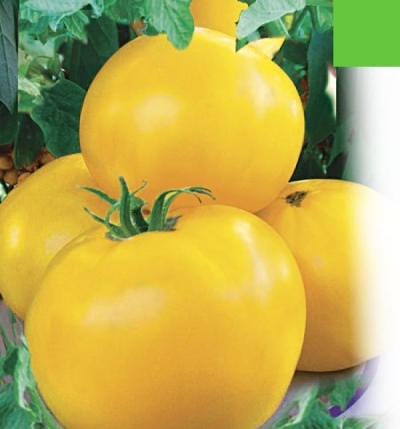
- Authors: Ognev V.V., Maksimov S.V., Klimenko N.N., Kostenko A.N. (LLC "Agrofirma Poisk")
- Year of approval: 2008
- Category: grade
- Growth type: indeterminate
- Appointment: universal
- Ripening period: mid-season
- Ripening time, days: 110-115
- Growing conditions: for open ground, for film greenhouses
- Transportability: good
- Bush size: tall
Gardeners, lovers of large-fruited and unpretentious tomatoes should pay close attention to the indeterminate variety Ilya Muromets. This universal-purpose plant is distinguished by strong immunity, unpretentiousness and the ability to grow throughout Russia. Its fruits are eaten fresh, used for canning in slices, in summer and winter salads, sauces and juices are made from it. Tomatoes are grown both in the open field and in greenhouses and hotbeds. The berries are distinguished by a high marketable yield, excellent transportability and good keeping quality.
Breeding history
The variety was approved for use in 2008, originators - V. V. Ognev, S. V. Kostenko, N. N. Klimenko, A. N. Kostenko, breeders of the company LLC "Agrofirma Poisk".
Description of the variety
An indeterminate powerful bush has different growth rates, which depends on the growing method. In greenhouses, it reaches 1.5-2 m, while in open ground it is much lower - on average 0.8-1 m.
Advantages of Ilya Muromets:
excellent taste and attractive appearance;
good keeping quality and transportability;
strong immunity, unpretentiousness, productivity;
large-fruited, versatility, resistance to cracking;
the berry is characterized by an increased concentration of such a powerful antioxidant as beta-carotene;
The fruits are safe for people who are allergic to red fruits and vegetables and can be consumed by those with gastrointestinal problems.
Tomato shoots are covered with large dark green leaves, yellow flowers are collected in intermediate inflorescences. The brush ties 5 to 6 berries attached to a strong, articulated stalk.
The main qualities of the fruit
Large (from 200 g) flat-round fruits, green in an immature state, change color to intense yellow-orange at the stage of technical ripeness. The berry has weakly expressed seed chambers containing a limited number of seeds.
Taste characteristics
Fleshy pulp of medium density has a balanced taste with a sufficient sugar content (3.5 to 4%), moderate acidity, covered with a smooth shiny skin. The berry contains 5% dry matter.
Ripening and fruiting
The tomato belongs to the mid-ripening category - the declared ripening period is from 110 to 115 days, however, more accurate indicators differ depending on the regions. Harvesting begins in the last decade of July and ripening tomatoes are harvested until the end of August.
Yield
The yield of Ilya Muromets allows you to get up to 10 kilograms from 1 square meter of ripe and tasty leveled fruits.
The timing of planting seedlings and planting in the ground
The optimal time for sowing seeds is from March 1 to March 20, seedlings are planted in a permanent place on May 10-20 in greenhouses, in open ground - after the threat of recurrent frosts has passed.

Growing tomato seedlings is an extremely important process, because it largely depends on whether the gardener can harvest at all. All aspects must be taken into account, from seedbed preparation to planting in the ground.
Landing scheme
The optimal distance between the bushes is 70x50 cm.

Growing and caring
Before transferring the seedlings to a permanent place, it must be hardened. Plants begin to accustom themselves to the external environment in about two weeks, taking out containers with seedlings to the street or balconies. Young immature plants should get used to the ambient temperature, its daily fluctuations and bright sunlight.
The soil in the ridges is deoxidized (if necessary) with chalk, lime, bone or dolomite flour, achieving a neutral pH level. To make the dense, heavy soil loose and breathable, cereal husks are introduced. Humus, mineral fertilizers, wood ash are introduced into the holes, stakes are installed for support. After planting, the soil around the plant is compacted, spilled with warm water, and the next day it is loosened to provide oxygen to the roots. Further care for the tomato consists in traditional activities - the formation of a bush in 1-3 stems, pinching, watering, weeding, feeding, hilling.




A plant needs different micronutrients at each stage of growth. All fertilizers can be divided into two groups: mineral and organic. Folk remedies are often used: iodine, yeast, bird droppings, eggshells.
It is important to observe the rate and period of feeding. This also applies to folk remedies and organic fertilizers.
Disease and pest resistance
The Ilya Muromets variety has a strong immunity. The tomato is resistant to top rot, but nothing can oppose pests. To avoid damage and death, plants need preventive treatments with insecticides and fungicides.


Resistant to adverse weather conditions
The plant is distinguished by its strong health and copes well with cold snaps, temperature extremes and heat. However, prolonged rains are dangerous for him, since the variety does not tolerate waterlogging poorly.
Growing regions
The Ilya Muromets variety is adapted for cultivation throughout Russia, from its southern regions to the northern ones, where the tomato sometimes needs shelter.It has proven itself well in the difficult conditions of the northern, northwestern, Ural, West Siberian, East Siberian and Far Eastern regions. In warmer districts, it does not need greenhouses and meets all the declared indicators. These are the Central Black Earth Region, Central, Volgo-Vyatka, North Caucasian, Middle Volga, Lower Volga regions.

























































































